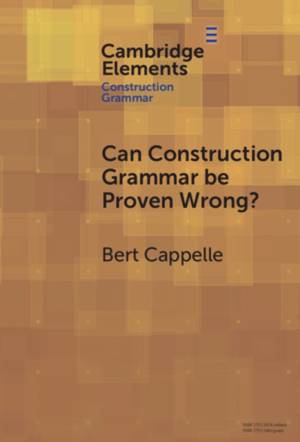
- Afhalen na 1 uur in een winkel met voorraad
- Gratis thuislevering in België vanaf € 30
- Ruim aanbod met 7 miljoen producten
- Afhalen na 1 uur in een winkel met voorraad
- Gratis thuislevering in België vanaf € 30
- Ruim aanbod met 7 miljoen producten
Zoeken
Omschrijving
Construction Grammar has gained prominence in linguistics, owing its popularity to its inclusive approach that considers language units of varying sizes and generality as potential constructions - mentally stored form-function units. This Element serves as a cautionary note against complacency and dogmatism. It emphasizes the enduring importance of falsifiability as a criterion for scientific hypotheses and theories. Can every postulated construction, in principle, be empirically demonstrated not to exist? As a case study, the author examines the schematic English transitive verb-particle construction, which defies experimental verification. He argues that we can still reject its non-existence using sound linguistic reasoning. But beyond individual constructions, what could be a crucial test for Construction Grammar itself, one that would falsify it as a theory? In making a proposal for such a test, designed to prove that speakers also exhibit pure-form knowledge, this Element contributes to ongoing discussions about Construction Grammar's theoretical foundations.
Specificaties
Betrokkenen
- Auteur(s):
- Uitgeverij:
Inhoud
- Aantal bladzijden:
- 82
- Taal:
- Engels
- Reeks:
Eigenschappen
- Productcode (EAN):
- 9781009478786
- Verschijningsdatum:
- 1/02/2024
- Uitvoering:
- Hardcover
- Formaat:
- Genaaid
- Afmetingen:
- 152 mm x 229 mm
- Gewicht:
- 281 g

Alleen bij Standaard Boekhandel
+ 209 punten op je klantenkaart van Standaard Boekhandel
Beoordelingen
We publiceren alleen reviews die voldoen aan de voorwaarden voor reviews. Bekijk onze voorwaarden voor reviews.











